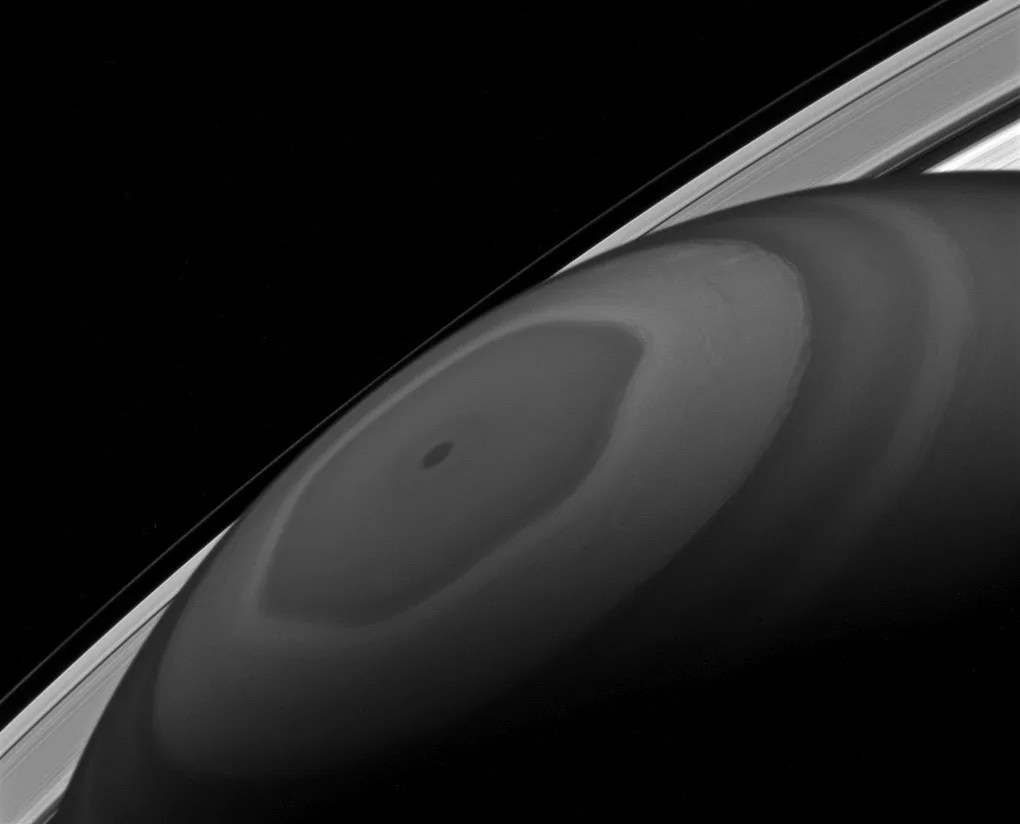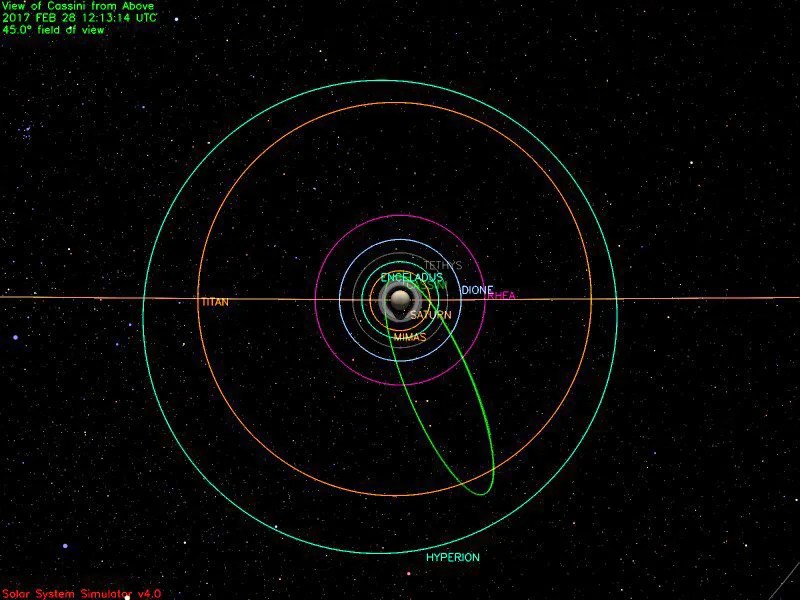8 min read

Cassini made its 13th plunge through Saturn's ring plane, close to the narrow, enigmatic F ring this week. Seven of these F-ring-grazing orbits remain in the mission, before starting in to the series of 22 Grand Finale orbits that will come even closer to Saturn. During this week's orbit, Cassini's Optical Remote Sensing (ORS) instruments made observations spanning the electromagnetic spectrum from the infra-red to the ultra-violet, examining the planet, some of its moons and its rings in the usual backscattered sunlight, and also backlit in forward-scattered sunlight. There were three occultations, which are of enormous scientific value, when the Sun or another much more distant star, happens to go behind Saturn or its rings or moons. All the while, Cassini's direct-sensing Magnetospheric and Plasma Science (MAPS) instruments performed various surveys, and one of them took center stage during the ring-plane crossing on Tuesday.
Wednesday, Feb. 22 (DOY 053)
The Sun disappeared behind Saturn from Cassini's point of view early today. With the Sun safely blocked, Cassini's telescopes -- the ORS instruments -- were able to observe at very high phase angles (that is, pointing close to the Sun) without suffering damage from intense sunlight. The advantage was that the population of micron-sized dust particles in these faint rings was highlighted. The Visible and Infrared Mapping Spectrometer (VIMS) spent five hours observing Saturn's faint rings, including the innermost D ring, near which Cassini will begin flying in April. The Imaging Science Subsystem (ISS) and the Composite Infrared Spectrometer (CIRS) rode along.
As the Sun reappeared from behind Saturn's limb, VIMS recorded the sunrise for 2.6 hours: a solar occultation by Saturn and its rings. The instrument was designed with an off-centerline "solar port," which can point to the Sun while keeping the other optics safely pointed away.
The spacecraft broke off communications during a Deep Space Network (DSN) session today, responding to commands to execute Orbit Trim Maneuver (OTM)-468A. The spacecraft turned and fired its small rocket thrusters for 207 seconds. This produced the required change in velocity of 0.2 meters per second, adjusting course for Cassini's final targeted encounter with Titan, T-126, which will occur on April 22. With the OTM completed, Cassini turned back and resumed two-way communications with Earth.
Near the end of the day, VIMS began observing a 5.3-hour occultation of the bright red star Alpha Orionis, also known as Betelgeuse. ISS and CIRS rode along, while the instruments' line of sight to the star passed through Saturn's broad A ring, then through the optically dense B ring, and then into the stranded C ring, before turning around and starting back outward.
The Cassini Project Scientist and Deputy Project Scientist attended a meeting of NASA’s Outer Planets Assessment Group (OPAG) today and the next day in Atlanta, Georgia.
The "Cassini Inspires" page has some delightful new additions: https://saturn.jpl.nasa.gov/mission/cassiniinspires .
Thursday, Feb. 23 (DOY 054)
ISS monitored the less optically thick components of Saturn's rings at high phase angles (largely sunlit from behind); CIRS rode along for this nearly six-hour observation.
Friday, Feb. 24 (DOY 055)
This illustration shows Cassini's high-phase viewing geometry for today: http://go.nasa.gov/2mLxwtz . Of note is the constellation Orion to the west, with its red Betelgeuse plainly visible. ISS spent two hours observing that thin, bright crescent limb of Saturn, with VIMS riding along.
CIRS then took the lead with an 8.5-hour stare at Saturn, measuring the atmosphere's chemical composition; UVIS and VIMS rode along. Next, while Cassini was rolling during communications with one of the Deep Space Network's stations in Australia, CIRS and the Ultraviolet Imaging Spectrograph conducted a survey of interplanetary hydrogen.
Today's featured image helps illustrate the complexity in the neighborhood of Saturn's F ring: /resources/17606 .
Saturday, Feb. 25 (DOY 056)
Cassini coasted through apoapsis early today, marking the start of Orbit #263. ISS performed another observation of Saturn's bright limb, at a lower phase angle than earlier this week, integrating for just over an hour. CIRS followed this with mapping of Saturn's northern hemisphere at mid-infrared wavelengths. During two complete Saturn rotations (22 hours), it measured temperatures in the atmosphere's upper troposphere and the tropopause. VIMS rode along with both of these activities.
Saturn appears on the left in the Astronomy Picture of the Day that NASA selected for today. The caption says it shows seven planets. The surface of an eighth planet is also very prominent on both the left and the right: https://apod.nasa.gov/apod/ap170225.html .
Sunday, Feb. 26 (DOY 057)
While Cassini was coming in over Saturn's high northern latitudes, UVIS observed the planet for seven hours. ISS, CIRS, and VIMS rode along for the first half, staring at one spot on the planet's atmosphere. For the second half, VIMS rode along for repeated slews across Saturn's sunlit auroral oval. These observations repeated on the following day, though only for a total of 4.6 hours. Finally today, VIMS led the other ORS instruments to map the Saturn’s northern hemisphere for eight hours.
In 60 days from today Cassini will speed through Saturn's ring plane at a point in between the planet's upper atmosphere and the innermost of its rings. This will be during the first of the mission's 22 Proximal, Grand Finale orbits.
Monday, Feb. 27 (DOY 058)
UVIS had the spacecraft turn and track Saturn's large icy moon Dione for 1.4 hours, examining its exosphere to search for any volatiles that might be coming from within the body. The observation included a stellar occultation, in which Dione passed in front of the ultraviolet-bright star Beta Crucis. The other ORS instruments rode along. Wrapping up the day's science activities, ISS and CIRS spent 90 minutes monitoring the clouds on Saturn's giant moon Titan.
Today's featured image was taken early last December when Cassini was in a similar spot as it was today, plunging over Sa Cruces turn's north pole. Its destination two days hence, near the thin strand of Saturn's F ring, was identifiable behind the giant planet: /resources/17607 .
Tuesday, Feb. 28 (DOY 059)
With Cassini careening over Saturn and going out towards the F ring, UVIS observed Saturn's auroral region with several slews over a period of 4.6 hours; CIRS, VIMS, and the Cosmic Dust Analyzer (CDA) rode along. ISS took the lead next, undertaking a 1.2-hour, "super high-resolution" radial scan of the sunlit side of Saturn's rings, looking for special targets; UVIS, CIRS, and VIMS all supported the observation by riding along. Commands had been specially prepared, and uplinked on Thursday to improve this observation, based on the latest available navigation solution. The commands updated the spacecraft's pointing capability to best track ring particles as they race around the giant planet at their various natural speeds, which are dictated by Kepler’s laws of orbital motion.
Cassini turned to favor the Magnetospheric Imaging Instrument (MIMI) for today's swift passage through the ring plane. The instrument was able to directly sense ring particles while close to the contorted F ring. The Radio and Plasma Wave Science (RPWS) instrument conducted a lightning search, by listening at radio frequencies for static-electric discharges, while the spacecraft was closest to the planet. Today's was Cassini's 13th close F-ring passage out of 20.
For the week's final science activity, CIRS began just over 13 hours of scans centered on Saturn's small active moon Enceladus; the other ORS instruments rode along.
The DSN communicated with and tracked Cassini on nine occasions this week, using stations in Australia and California. A total of 32 individual commands were uplinked, and about 1,540 megabytes of telemetry data were downlinked and captured at rates as high as 110,601 bits per second.
Wrap up:
Cassini is executing its set of F-ring-grazing orbits of Saturn, with a period of 7.2 days in a plane inclined 63.5 degrees from the planet's equatorial plane. The 20 orbits are nearly identical, with Cassini's nearest point at about 150,000 kilometers, and furthest point at about 1.28 million km from Saturn. Speeds relative to Saturn at those points (periapsis and apoapsis), are close to 76,150 km per hour and 9,000 km/h respectively.
The most recent spacecraft tracking and telemetry data were obtained on March 1 using one of the 34-meter diameter DSN stations in Australia. The spacecraft continues to be in an excellent state of health with all of its subsystems operating normally except for the instrument issues described at http://saturn.jpl.nasa.gov/anomalies .
The countdown clock in Mission Control shows 199 days until the end of the mission.
Cassini's orbit looks the same again this week, but the positions of spacecraft and moons are different, on this illustration of Cassini's path up to mid-day Feb. 28, 2017.








